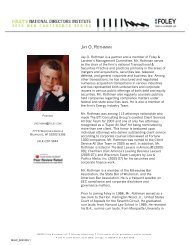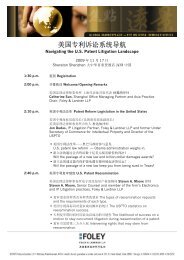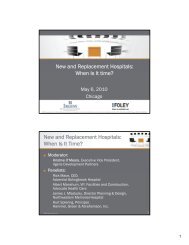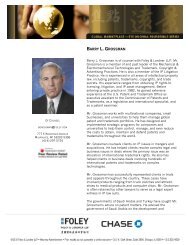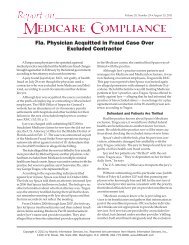Valuable Integration or Is It Time to Cut the Cord? - Foley & Lardner ...
Valuable Integration or Is It Time to Cut the Cord? - Foley & Lardner ...
Valuable Integration or Is It Time to Cut the Cord? - Foley & Lardner ...
You also want an ePaper? Increase the reach of your titles
YUMPU automatically turns print PDFs into web optimized ePapers that Google loves.
HEALTH LAW ANALYSIS<br />
OCTOBER 2008<br />
Hospital Systems Today—<br />
<strong>Valuable</strong> <strong>Integration</strong> <strong>or</strong> <strong>Is</strong> <strong>It</strong> <strong>Time</strong><br />
<strong>to</strong> <strong>Cut</strong> <strong>the</strong> C<strong>or</strong>d?<br />
By J. Mark Waxman and Janice A. Anderson, <strong>Foley</strong> & <strong>Lardner</strong> LLP<br />
intrOductiOn<br />
Since <strong>the</strong> early 90s, <strong>the</strong>re has been<br />
a well-documented trend by acute<br />
care hospitals <strong>to</strong>ward participation<br />
in healthcare systems. 1 Indeed,<br />
even <strong>to</strong>day, multi-hospital systems<br />
(Systems) continue <strong>to</strong> be created. 2<br />
Currently, over 55% of hospitals<br />
exist in a System of one kind <strong>or</strong><br />
ano<strong>the</strong>r, and System arrangements<br />
generally appear <strong>to</strong> provide value<br />
f<strong>or</strong> <strong>the</strong> members of <strong>the</strong> System<br />
individually, and f<strong>or</strong> <strong>the</strong> System as<br />
a whole. 3<br />
Over <strong>the</strong> past two years,<br />
however, <strong>the</strong>re have been signs<br />
that <strong>the</strong> effectiveness of Systems<br />
in delivering real value f<strong>or</strong> all of<br />
<strong>the</strong>ir members may be questioned.<br />
This can occur, f<strong>or</strong> example, when<br />
Systems are f<strong>or</strong>ced <strong>to</strong> fav<strong>or</strong> one<br />
member over ano<strong>the</strong>r in capital<br />
allocation decisions, <strong>or</strong> when<br />
hard decisions must be made with<br />
respect <strong>to</strong> marginally perf<strong>or</strong>ming<br />
entities, often those located in<br />
inner cities. As a result, we have<br />
seen a number of hospitals ei<strong>the</strong>r<br />
leaving one System f<strong>or</strong> ano<strong>the</strong>r,<br />
such as Mercy Hospital’s move<br />
from Catholic Healthcare East<br />
<strong>to</strong> <strong>the</strong> University of Pittsburgh<br />
System, <strong>or</strong> <strong>the</strong> departure of St.<br />
24 HEALTH LAWYERS NEWS<br />
Mary’s Hospital in Louisville from<br />
Catholic Health Initiatives <strong>to</strong> join<br />
<strong>the</strong> Jewish Hospital & St. Mary’s<br />
Inc. Healthcare System. The<br />
recently announced negotiation<br />
<strong>to</strong> separate Albert Einstein Health<br />
Netw<strong>or</strong>k from Jefferson Health<br />
System, which it joined a decade<br />
ago, may return an entity and its<br />
affiliates <strong>to</strong> freestanding status.<br />
And, as a reminder that Systems<br />
that cannot negotiate resolution of<br />
System issues peacefully may face<br />
challenging public disputes, <strong>the</strong>re<br />
is <strong>the</strong> ongoing litigation between<br />
The Christ Hospital and <strong>the</strong> Health<br />
Alliance of Cincinnati <strong>to</strong> effect its<br />
separation. 4<br />
This is not <strong>to</strong> suggest that <strong>the</strong><br />
only solution <strong>to</strong> System challenges<br />
is ei<strong>the</strong>r divestiture <strong>or</strong> dissolution.<br />
While some System models<br />
may be evolving <strong>to</strong>ward closer<br />
integration <strong>to</strong> achieve <strong>the</strong> values<br />
that “systemness” 5 can bring,<br />
a number of Systems (e.g. <strong>the</strong><br />
CareGroup Healthcare System in<br />
Bos<strong>to</strong>n, MA) have evolved in<strong>to</strong> a<br />
“confederate model” that seeks<br />
<strong>to</strong> maximize <strong>the</strong> purely financial<br />
benefits of System financing, but<br />
preserve <strong>the</strong> independence of<br />
System affiliates <strong>to</strong> operate within<br />
<strong>the</strong>ir markets, pursuing <strong>the</strong>ir own<br />
clinical initiatives.<br />
This article considers <strong>the</strong><br />
structure of Systems <strong>to</strong>day from<br />
<strong>the</strong> perspective of whe<strong>the</strong>r <strong>the</strong>y<br />
continue <strong>to</strong> have value. Then,<br />
drawing upon <strong>the</strong> example of <strong>the</strong><br />
Health Alliance of Cincinnati<br />
noted above, this article addresses<br />
situations where boards must assess<br />
<strong>the</strong> value of “systemness” <strong>or</strong> integration<br />
<strong>to</strong> determine whe<strong>the</strong>r it<br />
may indeed be outweighed by <strong>the</strong><br />
duties a System affiliate has <strong>to</strong> its<br />
own constituencies.<br />
<strong>the</strong> gOals underlying<br />
systems<br />
System creation, and <strong>the</strong> push<br />
<strong>to</strong> integrate hospitals in<strong>to</strong> multihospital<br />
nonprofit Systems, was <strong>the</strong><br />
product of a number of opp<strong>or</strong>tunities<br />
and market demands. While no<br />
one reason applies <strong>to</strong> every situation,<br />
<strong>the</strong> key fact<strong>or</strong>s that drove System<br />
creation in <strong>the</strong> early 90s were:<br />
1. The potential <strong>to</strong> create better<br />
access <strong>to</strong> capital and reduce <strong>the</strong><br />
cost of b<strong>or</strong>rowing through a large<br />
and diversified credit pool;<br />
2. Greater access <strong>to</strong> a pool of capital<br />
that can be spread across a<br />
System of affiliated hospitals;
3. A desire <strong>to</strong> achieve leverage in<br />
managed care contracting;<br />
4. Economies of scale in administrative<br />
services, purchasing, and<br />
revenue cycle activities that can<br />
result in lower operating costs<br />
and greater efficiency;<br />
5. Competitive advantages in<br />
markets where System hospitals<br />
can compete better with<br />
unaligned hospitals;<br />
6. The potential <strong>to</strong> enhance clinical<br />
management and quality initiatives<br />
across patient populations;<br />
7. The potential within markets <strong>to</strong><br />
integrate care delivery and create<br />
centers of excellence; and<br />
8. The ability <strong>to</strong> retain aggregate<br />
patient flows and revenues within<br />
System boundaries.<br />
<strong>the</strong> balance Of missiOn<br />
In <strong>the</strong> typical System, all members<br />
usually are <strong>or</strong>ganized as separate<br />
charitable nonprofit c<strong>or</strong>p<strong>or</strong>ations.<br />
The members typically have<br />
deep hist<strong>or</strong>ic roots in <strong>the</strong>ir local<br />
communities, and <strong>the</strong>ir missions<br />
and strategies traditionally have<br />
been purely local in nature. As a<br />
result, <strong>the</strong>ir assets (leaving aside<br />
restricted funds and endowments)<br />
are typically seen as pledged <strong>to</strong> <strong>the</strong><br />
benefit of locally related charitable<br />
activities. A local entity that<br />
changes <strong>the</strong> use of its existing<br />
assets <strong>to</strong> supp<strong>or</strong>t System goals must<br />
ensure that <strong>the</strong> change is consistent<br />
with legal requirements that apply<br />
<strong>to</strong> its charitable mission, and any<br />
attendant state-imposed charitable<br />
restrictions. 6 Thus, an imp<strong>or</strong>tant<br />
challenge f<strong>or</strong> all Systems is <strong>to</strong><br />
ensure that “systemness” does not<br />
thwart <strong>the</strong> charitable mission that<br />
grounded <strong>the</strong> participating System<br />
members in <strong>the</strong> first instance.<br />
In contrast <strong>to</strong> <strong>the</strong> specific and<br />
long-standing missions of most<br />
System members, <strong>the</strong> mission and<br />
goals of <strong>the</strong> System are generally<br />
new and necessarily must be stated<br />
broadly, so as <strong>to</strong> encompass <strong>the</strong><br />
varied missions of its individual<br />
Over <strong>the</strong> past two<br />
years . . . <strong>the</strong>re<br />
have been signs that<br />
<strong>the</strong> effectiveness of<br />
Systems in delivering<br />
real value f<strong>or</strong> all of<br />
<strong>the</strong>ir members may be<br />
questioned.<br />
members, and potentially a broader<br />
community. The Mission Statement<br />
f<strong>or</strong> <strong>the</strong> System can be found in <strong>the</strong><br />
documents that create <strong>the</strong> System,<br />
and must <strong>the</strong>n be carried f<strong>or</strong>ward<br />
<strong>to</strong> <strong>the</strong> governing documents<br />
(such as <strong>the</strong> Charter, Articles, and<br />
Bylaws) of <strong>the</strong> System parent, along<br />
with all System members.<br />
Unf<strong>or</strong>tunately, in many<br />
Systems, <strong>the</strong> statement of mission<br />
and goals rarely highlight any real<br />
difference between <strong>the</strong> mission of<br />
<strong>the</strong> individual affiliates and <strong>the</strong><br />
System as a whole. <strong>It</strong> can become<br />
a challenge, <strong>the</strong>ref<strong>or</strong>e, <strong>to</strong> discern<br />
where <strong>the</strong> boundaries and balance<br />
of <strong>the</strong> mission f<strong>or</strong> <strong>the</strong> System<br />
participants truly lies by looking at<br />
<strong>the</strong> stated mission and goals alone.<br />
This is particularly true when <strong>the</strong>re<br />
is conflict between <strong>the</strong> System<br />
parent and one of its members.<br />
Questions of mission and goals may<br />
become acute when Systems are<br />
confronted with issues of capital<br />
allocation, <strong>or</strong> in <strong>the</strong> event of intra-<br />
System clinical competition.<br />
allOcatiOn Of decisiOnmaking<br />
authOrity<br />
Aside from ensuring that <strong>the</strong> state<br />
protected charitable mission f<strong>or</strong><br />
<strong>the</strong> System members is safeguarded<br />
within a System context, <strong>the</strong> practical<br />
challenge <strong>to</strong> most Systems<br />
centers on <strong>the</strong> th<strong>or</strong>ny issue of<br />
where decision-making auth<strong>or</strong>ity<br />
within <strong>the</strong> System resides. Will <strong>the</strong><br />
System’s goals be best achieved if<br />
decision-making is centered at <strong>the</strong><br />
System parent level? Or are some<br />
decisions better made at <strong>the</strong> local<br />
level due <strong>to</strong> <strong>the</strong> unique nuances of<br />
<strong>the</strong> local market and its supp<strong>or</strong>tive<br />
constituency? The resolution of this<br />
auth<strong>or</strong>ity issue is complicated, and<br />
many Systems grapple with it long<br />
after <strong>the</strong>ir f<strong>or</strong>mation.<br />
Decision-making auth<strong>or</strong>ity is<br />
typically grouped in<strong>to</strong> categ<strong>or</strong>ies—<br />
which usually are articulated in <strong>the</strong><br />
c<strong>or</strong>p<strong>or</strong>ate documents through an<br />
enumeration of “reserved powers”<br />
held by <strong>the</strong> System parent. <strong>It</strong> is<br />
often embodied in a “governance”<br />
<strong>or</strong> “auth<strong>or</strong>ity matrix” delineating<br />
hierarchical decision-making<br />
auth<strong>or</strong>ity at <strong>the</strong> various decision<br />
points across <strong>the</strong> System. The<br />
typical auth<strong>or</strong>ity matrix addresses<br />
<strong>the</strong> division of auth<strong>or</strong>ity and<br />
responsibility between System<br />
affiliates and <strong>the</strong> System parent.<br />
As one model has expressed it, <strong>the</strong><br />
auth<strong>or</strong>ity matrix advises when <strong>the</strong><br />
affiliate <strong>or</strong> <strong>the</strong> parent must consult,<br />
recommend, notify, <strong>or</strong> approve<br />
any particular action <strong>or</strong> event. The<br />
key areas covered in <strong>the</strong> typical<br />
auth<strong>or</strong>ity hierarchy include <strong>the</strong><br />
following:<br />
1. Selection of membership on <strong>the</strong><br />
System parent Board and on<br />
Boards of <strong>the</strong> System affiliate<br />
(typically focused on <strong>the</strong> first<br />
tier affiliates);<br />
2. Determination of mission,<br />
strategic plan, and c<strong>or</strong>p<strong>or</strong>ate<br />
affiliations of <strong>the</strong> System parent<br />
and its affiliates;<br />
3. Approval of operating and<br />
capital budgets and targets;<br />
4. Creation <strong>or</strong> addition of new<br />
affiliates/joint ventures <strong>or</strong> long<br />
term contractual alignments;<br />
5. Financing activities;<br />
6. Maj<strong>or</strong> <strong>or</strong> material (as opposed <strong>to</strong><br />
sh<strong>or</strong>t term) capital expenditures;<br />
OCTOBER 2008<br />
25
HEALTH LAW ANALYSIS<br />
7. Capital allocation;<br />
8. Selection and removal of <strong>the</strong><br />
Chief Executive Officer of <strong>the</strong><br />
System parent and <strong>the</strong> affiliates;<br />
9. Material asset sales <strong>or</strong> divestitures;<br />
and<br />
10. Closure <strong>or</strong> significant expansion<br />
of clinical service lines.<br />
The range of ways Systems<br />
balance decision-making auth<strong>or</strong>ity<br />
is as varied as <strong>the</strong>re are Systems.<br />
Some Systems are “systemcentric”—with<br />
a large share of <strong>the</strong><br />
decisions <strong>to</strong> be resolved by, <strong>or</strong> only<br />
with <strong>the</strong> approval of, <strong>the</strong> System<br />
parent—while o<strong>the</strong>r Systems have<br />
limited centralization, f<strong>or</strong> example<br />
where <strong>the</strong> System parent’s auth<strong>or</strong>ity<br />
is limited <strong>to</strong> issues related <strong>to</strong><br />
centralized debt management. In<br />
all cases, however, <strong>the</strong> oversight<br />
auth<strong>or</strong>ity granted <strong>to</strong> <strong>the</strong> System<br />
parent is created by written documents;<br />
ei<strong>the</strong>r by a contract (e.g.<br />
through a Joint Operating Agreement),<br />
<strong>or</strong> by specific “reserved<br />
power” provisions in interrelated<br />
bylaws of <strong>the</strong> System parent and<br />
its affiliates. Although resolution<br />
of <strong>the</strong> “central vs. local” decisionmaking<br />
conundrum may vary<br />
widely, what remains in common<br />
f<strong>or</strong> virtually every System is <strong>the</strong><br />
tension between <strong>the</strong> need f<strong>or</strong><br />
central <strong>or</strong> local control.<br />
The tension that occurs as a<br />
result of <strong>the</strong> allocation of decisionmaking<br />
auth<strong>or</strong>ity is best illustrated<br />
when Systems face questions about<br />
<strong>the</strong> allocation <strong>or</strong> reallocation of<br />
assets between System members.<br />
F<strong>or</strong> example, assume System A has<br />
five hospitals scattered over five<br />
separate markets. Assume fur<strong>the</strong>r<br />
than one of <strong>the</strong> System hospitals<br />
is located in a fav<strong>or</strong>able market<br />
and is earning banner operating<br />
margins, while ano<strong>the</strong>r System<br />
hospital, located in a m<strong>or</strong>e challenging<br />
market, is losing money.<br />
From <strong>the</strong> System perspective, <strong>the</strong><br />
imbalance could easily be recti-<br />
26 HEALTH LAWYERS NEWS<br />
Unf<strong>or</strong>tunately, in many<br />
Systems, <strong>the</strong> statement<br />
of mission and goals<br />
rarely highlight<br />
any real difference<br />
between <strong>the</strong> mission<br />
of <strong>the</strong> individual<br />
affiliates and <strong>the</strong><br />
System as a whole.<br />
fied by simply allocating operating<br />
income from <strong>the</strong> “good” hospital<br />
<strong>to</strong> its under-perf<strong>or</strong>ming affiliate.<br />
In a strong centralized decisionmaking<br />
model, implemented<br />
through <strong>the</strong> System governance<br />
documents, <strong>the</strong> System parent<br />
could make this transfer, presumably<br />
<strong>to</strong> <strong>the</strong> benefit of <strong>the</strong> System as<br />
a whole. However, is this really <strong>to</strong><br />
<strong>the</strong> benefit of <strong>the</strong> well-perf<strong>or</strong>ming<br />
entity and, m<strong>or</strong>e imp<strong>or</strong>tantly, <strong>to</strong><br />
<strong>the</strong> community it serves? The wellperf<strong>or</strong>ming<br />
hospital may consider<br />
this asset allocation <strong>to</strong> undermine<br />
its ability <strong>to</strong> meet its local mission,<br />
by diverting its assets <strong>to</strong> its po<strong>or</strong>er<br />
affiliate. This conflict created when<br />
decisions affect <strong>the</strong> “good of <strong>the</strong><br />
whole” versus <strong>the</strong> “good of <strong>the</strong><br />
component,” and <strong>the</strong> ability of <strong>the</strong><br />
System <strong>to</strong> peacefully resolve <strong>the</strong>m,<br />
can test <strong>the</strong> very fabric of “systemness,”<br />
creating fertile ground f<strong>or</strong><br />
claims <strong>to</strong> disaffiliate.<br />
system unwind prOvisiOns<br />
As some systems have come<br />
<strong>to</strong>ge<strong>the</strong>r, particularly when <strong>the</strong><br />
“glue” is contractual ra<strong>the</strong>r than<br />
through a c<strong>or</strong>p<strong>or</strong>ate membership<br />
model, different approaches <strong>to</strong><br />
defining when <strong>to</strong> terminate <strong>the</strong><br />
arrangement have been used.<br />
In some cases, withdrawal is not<br />
allowed so long as certain measures<br />
of success are achieved. In o<strong>the</strong>rs,<br />
withdrawal is permitted at <strong>the</strong><br />
election of a System participant.<br />
One straightf<strong>or</strong>ward approach is<br />
a defined withdrawal agreement<br />
that allows withdrawal by any<br />
participant after a fixed time (e.g.<br />
10-20 years) has elapsed, with a<br />
process <strong>to</strong> unwind <strong>the</strong> arrangement<br />
including reallocation <strong>or</strong><br />
unwinding of capital and debt. If<br />
<strong>the</strong> parties believe <strong>the</strong> arrangement<br />
remains mutually beneficial,<br />
<strong>the</strong>y can agree <strong>to</strong> “re-up” in <strong>the</strong><br />
arrangement. If not, <strong>the</strong>re can be<br />
an <strong>or</strong>derly withdrawal.<br />
A second approach is one<br />
that allows f<strong>or</strong> affiliate withdrawal<br />
if certain metrics applied <strong>to</strong> <strong>the</strong><br />
System as a whole are met, at <strong>the</strong><br />
option of ei<strong>the</strong>r <strong>the</strong> parent <strong>or</strong> <strong>the</strong><br />
affiliate. These metrics typically<br />
may include:<br />
• A demonstration that no<br />
financing <strong>or</strong> contractual defaults<br />
would occur from <strong>the</strong> withdrawal;<br />
• Financing metrics f<strong>or</strong> <strong>the</strong> System<br />
that remain at <strong>the</strong> same levels<br />
post-departure (e.g. days of cash<br />
on hand, capitalization ratio);<br />
and<br />
• After withdrawal, <strong>the</strong> withdrawing<br />
member can obtain<br />
comparable financing as it could<br />
within <strong>the</strong> System.<br />
The f<strong>or</strong>egoing metrics generally are<br />
seen as a “do no harm” approach <strong>to</strong><br />
withdrawal.<br />
A third approach avoids<br />
defined departure “trigger”<br />
metrics f<strong>or</strong> withdrawal but allows<br />
<strong>the</strong> parties <strong>to</strong> discuss disaffiliation<br />
at given intervals. Under this<br />
approach, <strong>the</strong>re is an evaluation of<br />
whe<strong>the</strong>r <strong>the</strong> System and its affiliates<br />
are meeting <strong>the</strong> goals of <strong>the</strong>ir stra-
tegic and capital plans that usually<br />
have been developed as an initial<br />
step following integration.<br />
Ano<strong>the</strong>r approach requires <strong>the</strong><br />
System <strong>to</strong> develop specific goals,<br />
both at <strong>the</strong> System and affiliate<br />
level that, if not attained, may<br />
trigger <strong>the</strong> right of any member of<br />
<strong>the</strong> System <strong>to</strong> withdraw. Such goals<br />
might include whe<strong>the</strong>r <strong>the</strong> System<br />
and each of its affiliates have<br />
achieved an agreed-upon operating<br />
margin within a defined time<br />
period, <strong>or</strong> whe<strong>the</strong>r an agreed-upon<br />
amount of new capital has been<br />
generated f<strong>or</strong> System affiliates over<br />
an agreed time period.<br />
The key <strong>to</strong> each of <strong>the</strong>se<br />
approaches is, of course, an ability<br />
<strong>to</strong> reach an agreement initially<br />
among System members on <strong>the</strong><br />
appropriate benchmarks <strong>to</strong> success.<br />
That agreement, which may be<br />
ei<strong>the</strong>r in <strong>the</strong> f<strong>or</strong>m of defined<br />
metrics <strong>or</strong> a defined process <strong>to</strong><br />
identify those metrics, is best<br />
reached through negotiation pri<strong>or</strong><br />
<strong>to</strong> System creation. This allows f<strong>or</strong><br />
clarity and understanding by <strong>the</strong><br />
respective parties of <strong>the</strong>ir shared<br />
goals, and how <strong>the</strong>y have agreed <strong>to</strong><br />
achieve <strong>the</strong>m, and should be carefully<br />
documented in <strong>the</strong> <strong>or</strong>ganizational<br />
documents.<br />
testing <strong>the</strong> system—<strong>the</strong><br />
cincinnati health alliance<br />
experience<br />
The Health Alliance of Greater<br />
Cincinnati (Alliance) was created<br />
in 1995. Using a Joint Operating<br />
Agreement (JOA), The<br />
Christ Hospital, (TCH), St. Luke<br />
Hospital, <strong>the</strong> University of Cincinnati<br />
College of Medicine, Jewish<br />
Health System, and F<strong>or</strong>t Hamil<strong>to</strong>n<br />
Hospital (known collectively as<br />
Participating Entities), came<br />
<strong>to</strong>ge<strong>the</strong>r by contract <strong>to</strong> create a<br />
“virtual merger” of <strong>the</strong> Participating<br />
Entities. Unf<strong>or</strong>tunately, a<br />
dispute erupted where, in <strong>the</strong> view<br />
of <strong>the</strong> court in which <strong>the</strong> litigation<br />
is pending, <strong>the</strong>re was “a clash<br />
of fundamental perceptions over<br />
what kind of structure” had been<br />
created. 7<br />
The JOA (as subsequently<br />
amended in 2001) articulated a<br />
structure f<strong>or</strong> <strong>the</strong> Alliance that<br />
included <strong>the</strong> following elements:<br />
1. Strategic Goals that included <strong>the</strong><br />
goal of enhancing <strong>the</strong> healthcare<br />
needs of <strong>the</strong> communities<br />
served by <strong>the</strong> Participating<br />
Entities through an integrated<br />
delivery system, and through<br />
<strong>the</strong> development of shared risk<br />
arrangements;<br />
2. The f<strong>or</strong>mation of a Joint Operating<br />
Company (JOC)—i.e. <strong>the</strong><br />
Alliance parent entity—which<br />
was <strong>to</strong> have responsibility f<strong>or</strong> <strong>the</strong><br />
“overall management and supervision”<br />
of <strong>the</strong> Alliance, with <strong>the</strong><br />
auth<strong>or</strong>ity <strong>to</strong> enter in<strong>to</strong> contracts<br />
on behalf of <strong>the</strong> Participating<br />
Entities (subject <strong>to</strong> reserved<br />
powers), as well as <strong>to</strong> develop,<br />
administer, conduct, and<br />
carry out marketing and business<br />
development, consolidate<br />
management and, m<strong>or</strong>e generally,<br />
“manage and oversee daily<br />
operations of <strong>the</strong> Alliance;”<br />
3. The property, plant, and equipment<br />
of <strong>the</strong> Participating Entities<br />
would continue <strong>to</strong> reside in each<br />
entity, subject <strong>to</strong> <strong>the</strong> power of <strong>the</strong><br />
JOC <strong>to</strong> “in its discretion . . . cause<br />
a Participating Entity <strong>to</strong> relocate<br />
<strong>or</strong> transfer ownership of its<br />
[property, plant and equipment]<br />
<strong>to</strong> <strong>the</strong> JOC <strong>or</strong> ano<strong>the</strong>r Participating<br />
Entity;”<br />
4. The Participating Entities <strong>the</strong>mselves<br />
were <strong>to</strong> continue <strong>to</strong> exercise<br />
“ultimate responsibility f<strong>or</strong><br />
fulfilling <strong>the</strong>ir respective charitable<br />
missions and obligations;”<br />
5. The JOC itself was <strong>to</strong> operate<br />
consistent with <strong>the</strong> charitable<br />
missions of <strong>the</strong> Participating<br />
Entities;<br />
6. <strong>It</strong> was an event of default f<strong>or</strong> <strong>the</strong><br />
JOC <strong>to</strong> fail <strong>to</strong> comply with <strong>the</strong><br />
JOA provisions; and<br />
7. An uncured default would permit<br />
a Participating Entity <strong>to</strong> terminate<br />
its participation and withdraw<br />
from <strong>the</strong> Alliance.<br />
At <strong>the</strong> Alliance’s inception, all<br />
Participating Entities saw mutual<br />
advantage. Over time, however,<br />
those views changed dramatically.<br />
By mid-2006, <strong>the</strong> TCH Board<br />
concluded that, although TCH<br />
generated 40% of Alliance revenues,<br />
it was being under funded<br />
by <strong>the</strong> JOC, while <strong>the</strong> Alliance<br />
was devoting significant capital <strong>to</strong><br />
build a new hospital. Where <strong>the</strong><br />
JOC questioned TCH’s viability<br />
in its current location and even<br />
envisioned an abs<strong>or</strong>ption of TCH<br />
by ano<strong>the</strong>r Alliance member (<strong>the</strong><br />
University Hospitals), <strong>the</strong> TCH<br />
Board, after its own investigation<br />
of <strong>the</strong> facts, concluded that TCH<br />
not only could be successful with <strong>or</strong><br />
without its membership in <strong>the</strong> Alliance,<br />
but, because of <strong>the</strong> Alliance’s<br />
failure <strong>to</strong> realize <strong>the</strong> value of its<br />
clinical goals, THC could well<br />
be stronger in <strong>the</strong> pursuit of its<br />
mission if it became independent.<br />
Ultimately, TCH decided <strong>to</strong> withdraw<br />
from <strong>the</strong> Alliance, because<br />
continued participation was no<br />
longer in <strong>the</strong> best interests of<br />
TCH’s charitable mission as determined<br />
by <strong>the</strong> TCH Board, which<br />
had reserved <strong>to</strong> it <strong>the</strong> “ultimate”<br />
auth<strong>or</strong>ity over decisions respecting<br />
THC’s mission.<br />
The TCH termination notice<br />
was followed sh<strong>or</strong>tly <strong>the</strong>reafter by<br />
a similar notice of termination<br />
from St. Luke’s Hospitals. Like<br />
TCH’s Board, St. Luke’s Board<br />
acted as <strong>the</strong> result of a number of<br />
issues, some past and some current,<br />
including a claimed mishandling<br />
by <strong>the</strong> JOC of a maj<strong>or</strong> source of<br />
patient referrals, JOC eff<strong>or</strong>ts <strong>to</strong><br />
obligate St. Luke’s <strong>to</strong> joint and<br />
OCTOBER 2008<br />
27
HEALTH LAW ANALYSIS<br />
several financing obligations over<br />
its objections, and a refusal by <strong>the</strong><br />
JOC <strong>to</strong> expl<strong>or</strong>e a voluntary withdrawal<br />
despite a showing that <strong>the</strong><br />
economics of <strong>the</strong> withdrawal would<br />
benefit <strong>the</strong> Alliance.<br />
Litigation between <strong>the</strong> parties<br />
commenced in March 2006, when<br />
<strong>the</strong> Alliance sued TCH <strong>to</strong> obtain<br />
a declarat<strong>or</strong>y ruling <strong>to</strong> prevent<br />
its withdrawal. Notwithstanding<br />
court rulings in fav<strong>or</strong> of TCH and<br />
St. Luke’s, <strong>the</strong> litigation continues<br />
<strong>to</strong>day and has drawn o<strong>the</strong>r parties,<br />
such as <strong>the</strong> Ohio Att<strong>or</strong>ney General,<br />
in<strong>to</strong> <strong>the</strong> fray.<br />
To resolve <strong>the</strong> issues raised by<br />
<strong>the</strong> litigation, <strong>the</strong> court has focused<br />
on two key elements—(1) <strong>to</strong> what<br />
did <strong>the</strong> parties actually agree, and<br />
what duties were created as a result<br />
of <strong>the</strong>ir agreement; and (2) was<br />
<strong>the</strong> subsequent decision-making<br />
of <strong>the</strong> parties consistent with <strong>the</strong>ir<br />
agreed-upon duties and <strong>the</strong>ir<br />
inherent obligations. Thus, <strong>the</strong><br />
analysis began with <strong>the</strong> JOA and<br />
o<strong>the</strong>r <strong>or</strong>ganizational documents,<br />
and <strong>the</strong>n progressed <strong>to</strong> analyze<br />
<strong>the</strong> parties’ actions in light of <strong>the</strong>ir<br />
agreed-upon obligations and <strong>the</strong><br />
general common law legal principles<br />
governing decision-making by<br />
those involved in such structures.<br />
Although on its face <strong>the</strong> JOA<br />
provided a great deal of operational<br />
auth<strong>or</strong>ity in <strong>the</strong> JOC, it also<br />
provided that <strong>the</strong> power of <strong>the</strong><br />
Participating Entities’ Boards <strong>to</strong><br />
exercise “ultimate” responsibility<br />
was unabridged. Because <strong>the</strong> JOA<br />
articulated that <strong>the</strong> JOC was <strong>to</strong><br />
“operate <strong>the</strong> Alliance consistent<br />
with <strong>the</strong> charitable missions” of<br />
<strong>the</strong> Participating Entities, all of<br />
<strong>the</strong> relevant JOC decisions were<br />
<strong>to</strong> be measured with that goal in<br />
mind. As <strong>the</strong> court noted, although<br />
some may have visualized a “virtual<br />
merger” at inception, in fact, no<br />
“virtual merger” existed at all.<br />
Instead, <strong>the</strong> Participating Entity<br />
retained its right <strong>to</strong> determine its<br />
28 HEALTH LAWYERS NEWS<br />
The resolution of<br />
this auth<strong>or</strong>ity issue<br />
is complicated, and<br />
many Systems grapple<br />
with it long after <strong>the</strong>ir<br />
f<strong>or</strong>mation.<br />
own separate mission, and <strong>the</strong>re<br />
was no agreement (<strong>or</strong>, as a result,<br />
no requirement) that a single<br />
overriding <strong>or</strong> even system-consistent<br />
charitable mission was <strong>to</strong> be<br />
achieved. 8<br />
The court, however, looked<br />
beyond <strong>the</strong> JOA’s specific provisions<br />
<strong>to</strong> find a higher <strong>or</strong> fiduciary duty in<br />
<strong>the</strong> JOC <strong>to</strong> <strong>the</strong> Participating Entities<br />
by virtue of its “special relationship”<br />
with <strong>the</strong>m. Because, subject<br />
<strong>to</strong> certain reserved powers, <strong>the</strong> JOC<br />
was charged with <strong>the</strong> obligation <strong>to</strong><br />
manage <strong>the</strong> affairs of <strong>the</strong> Participating<br />
Entities, collect and allocate<br />
<strong>the</strong>ir revenues, and employ <strong>the</strong>ir<br />
operational staffs, <strong>the</strong> JOC was<br />
duty-bound <strong>to</strong> act, not f<strong>or</strong> itself <strong>or</strong><br />
f<strong>or</strong> <strong>the</strong> Alliance as a whole, but as a<br />
fiduciary <strong>to</strong> <strong>the</strong> Participating Entities<br />
individually. The court found<br />
this duty was breached, providing a<br />
basis f<strong>or</strong> <strong>the</strong> Participating Entities<br />
<strong>to</strong> terminate <strong>the</strong> arrangement.<br />
While <strong>the</strong> Alliance JOA structure<br />
may be seen as unique among<br />
Systems, <strong>the</strong> lessons of <strong>the</strong> litigation<br />
are many. First, <strong>the</strong> JOA terms<br />
were inconsistent and left gaps in<br />
defining governance obligations.<br />
On <strong>the</strong> one hand, <strong>the</strong> JOC was obligated<br />
<strong>to</strong> manage (with imp<strong>or</strong>tant<br />
reserved powers) <strong>the</strong> affairs of <strong>the</strong><br />
Participating Entities, and <strong>to</strong> do so<br />
with <strong>the</strong> supp<strong>or</strong>t of <strong>the</strong>ir revenue<br />
streams and with control over<br />
financing and access <strong>to</strong> capital.<br />
On <strong>the</strong> o<strong>the</strong>r hand, <strong>the</strong> unique<br />
mission of each Participating Entity<br />
was preserved, and <strong>the</strong> obligation<br />
<strong>to</strong> achieve that mission was<br />
left <strong>to</strong> <strong>the</strong> ultimate control of <strong>the</strong><br />
Boards of <strong>the</strong> applicable Participating<br />
Entity. The lesson learned<br />
is deceptively straightf<strong>or</strong>ward:<br />
<strong>the</strong>re must be congruity between<br />
power, auth<strong>or</strong>ity, responsibility and<br />
mission at <strong>the</strong> System parent level.<br />
In addition, although Participating<br />
Entity consent was required<br />
by <strong>the</strong> JOA <strong>to</strong> impose new joint<br />
and several debt obligations on <strong>the</strong><br />
Participating Entities, <strong>the</strong> JOC had<br />
sought <strong>to</strong> impose those obligations<br />
without consent. The JOC also had<br />
taken a series of strategic actions<br />
without an agreed-upon strategic<br />
plan (which was required by <strong>the</strong><br />
JOA) and <strong>the</strong>se strategies impacted<br />
directly <strong>the</strong> mission driven desires<br />
of two of <strong>the</strong> five Participating<br />
Entities. In sh<strong>or</strong>t, <strong>the</strong> facts showed<br />
that <strong>the</strong> JOC had acted inconsistent<br />
with terms articulated in <strong>the</strong><br />
JOA, and in violation of its duties<br />
(deemed fiduciary duties by <strong>the</strong><br />
court) <strong>to</strong> <strong>the</strong> Participating Entities,<br />
allowing TCH and St. Luke’s <strong>to</strong><br />
invoke <strong>the</strong>ir right <strong>to</strong> withdraw. This<br />
result also could have been easily<br />
f<strong>or</strong>eseen. Operation without a clear<br />
framew<strong>or</strong>k in this kind of environment<br />
can result in m<strong>or</strong>e than just<br />
anxiety and bad feelings.<br />
implicatiOns fOr systems<br />
and <strong>the</strong>ir bOards<br />
How did <strong>the</strong> Cincinnati situation<br />
happen, and how could it have<br />
been avoided? The fundamental<br />
flaw in <strong>the</strong> Alliance structure<br />
<strong>or</strong>iginated from a lack of a clearly<br />
defined, agreed-upon, common<br />
mission and vision f<strong>or</strong> <strong>the</strong> Alliance,<br />
approved and adopted by<br />
<strong>the</strong> Boards of all of <strong>the</strong> Participating<br />
Entities and articulated in<br />
a strategic plan approved by all<br />
of <strong>the</strong> Alliance Boards. Common<br />
mission/vision and strategic
HEALTH LAW ANALYSIS<br />
plan are essential at <strong>the</strong> outset <strong>to</strong><br />
establish “systemness” and should<br />
be embraced by all participants<br />
in <strong>the</strong> System. The participants<br />
should all conclude that <strong>the</strong><br />
System mission/vision and plan<br />
bring <strong>the</strong>m sufficient value <strong>to</strong> be<br />
w<strong>or</strong>thwhile <strong>to</strong> meet both sh<strong>or</strong>t<br />
and longer terms goals.<br />
In addition, <strong>the</strong> Alliance failed<br />
<strong>to</strong> precisely identify an auth<strong>or</strong>ity<br />
matrix <strong>to</strong> make clear <strong>the</strong> relative<br />
decision-making auth<strong>or</strong>ity of <strong>the</strong><br />
JOC vis-à-vis <strong>the</strong> Participating<br />
Entities. The auth<strong>or</strong>ity matrix<br />
must implement <strong>the</strong> agreed-upon<br />
balance of governance responsibilities,<br />
cascaded <strong>to</strong> management, that<br />
is sought by <strong>the</strong> participants from<br />
<strong>the</strong> System. F<strong>or</strong> example, if <strong>the</strong> only<br />
value <strong>to</strong> <strong>the</strong> System participants is<br />
financial, <strong>the</strong>n <strong>the</strong> auth<strong>or</strong>ity matrix<br />
(including all relevant c<strong>or</strong>p<strong>or</strong>ate<br />
documents) should allocate<br />
decision-making auth<strong>or</strong>ity <strong>to</strong> <strong>the</strong><br />
System parent around that element,<br />
and control in o<strong>the</strong>r areas, such as<br />
clinical <strong>or</strong> operational decisions,<br />
should remain at <strong>the</strong> local level.<br />
If, on <strong>the</strong> o<strong>the</strong>r hand, <strong>the</strong> value of<br />
<strong>the</strong> “systemness” extends beyond<br />
financial issues <strong>to</strong> competitive and<br />
clinical activities, <strong>the</strong>n <strong>the</strong> governance<br />
and management responsibilities<br />
identified in <strong>the</strong> auth<strong>or</strong>ity<br />
matrix should reflect that as well.<br />
Finally, <strong>the</strong> JOC seemingly<br />
failed <strong>to</strong> focus properly on its<br />
duties <strong>to</strong> <strong>the</strong> Participating Entities<br />
individually, and, instead, focused<br />
narrowly on what it perceived<br />
<strong>to</strong> be best f<strong>or</strong> <strong>the</strong> System as a<br />
whole. Given that <strong>the</strong> individual<br />
Participating Entities remained<br />
committed <strong>to</strong> use <strong>the</strong>ir charitable<br />
assets <strong>to</strong> fulfill charitable purposes<br />
of <strong>the</strong> communities <strong>the</strong>y served,<br />
a narrow focus solely on what is<br />
in <strong>the</strong> best interest of <strong>the</strong> System<br />
constituted a fundamental breach<br />
of <strong>the</strong> JOC’s fiduciary obligation<br />
<strong>to</strong> <strong>the</strong> Participating Entities,<br />
paving <strong>the</strong> way f<strong>or</strong> <strong>the</strong> Alliance’s<br />
30 HEALTH LAWYERS NEWS<br />
disintegration (and some very<br />
acrimonious litigation). By<br />
ascribing a fiduciary duty <strong>to</strong> <strong>the</strong><br />
JOC in fav<strong>or</strong> of <strong>the</strong> Participating<br />
Entities, <strong>the</strong> balance between <strong>the</strong><br />
needs, desires, and goals of <strong>the</strong><br />
Alliance as a whole vis-à-vis <strong>the</strong><br />
Participating Entities was decided.<br />
The JOC’s duty <strong>to</strong> supp<strong>or</strong>t <strong>the</strong><br />
Participating Entities would trump<br />
<strong>the</strong> System in every case.<br />
<strong>the</strong> value Of systems: time<br />
fOr an evaluatiOn<br />
In 1996, James Orlihoff and Mary<br />
Totten described <strong>the</strong> characteristics<br />
of an integrated delivery system. 9<br />
The elements included:<br />
• <strong>Integration</strong> of care delivery and<br />
financing.<br />
• <strong>Integration</strong> of physicians with <strong>the</strong><br />
<strong>or</strong>ganization.<br />
• Provision of an accessible<br />
continuum of care.<br />
• Provision of high-quality, costeffective<br />
care resulting from <strong>the</strong><br />
integration of services and clinicians.<br />
• A new f<strong>or</strong>m of integrated,<br />
systems-<strong>or</strong>iented governance.<br />
Now, a decade later, <strong>the</strong> success<br />
of this model in truly achieving<br />
<strong>the</strong>se characteristics and realizing<br />
value is being tested. On <strong>the</strong><br />
one hand, <strong>the</strong>re appears <strong>to</strong> be<br />
consensus that scale itself offers<br />
substantial benefits; if, f<strong>or</strong> no o<strong>the</strong>r<br />
reason, it allows better access <strong>to</strong><br />
capital. 10 These benefits can be<br />
realized, however, provided <strong>the</strong>re is<br />
an adequate capital base <strong>to</strong> manage<br />
from at <strong>the</strong> outset, an agreement<br />
on common goals and strategy,<br />
and an overall objective <strong>to</strong> maintain<br />
and grow each of <strong>the</strong> System’s<br />
participants, if only from a financial<br />
perspective.<br />
The test arises, however,<br />
when <strong>the</strong> conditions change over<br />
time—<strong>the</strong> money <strong>to</strong> meet capital<br />
needs declines requiring difficult<br />
choices as <strong>to</strong> where <strong>to</strong> allocate<br />
dwindling funds, profitability<br />
across <strong>the</strong> system declines, <strong>or</strong> <strong>the</strong><br />
markets change reducing returns<br />
on capital investment, <strong>or</strong> clinical<br />
integration has simply posed <strong>to</strong>o<br />
big of a challenge. The participants<br />
in Systems seeking <strong>to</strong> address <strong>the</strong>se<br />
circumstances will need <strong>to</strong> hearken<br />
back <strong>to</strong> <strong>the</strong> agreed-upon goals that<br />
brought <strong>the</strong>m <strong>to</strong>ge<strong>the</strong>r initially<br />
and evaluate whe<strong>the</strong>r those goals<br />
remain. If <strong>the</strong>y do, <strong>the</strong>n System<br />
can honestly determine whe<strong>the</strong>r<br />
<strong>the</strong> goals, <strong>or</strong> at least some of <strong>the</strong>m,<br />
still can be achieved and whe<strong>the</strong>r<br />
“systemness” continues <strong>to</strong> deliver<br />
value f<strong>or</strong> <strong>the</strong> System, both individually<br />
and collectively. This requires<br />
high-level, objective review and<br />
evaluation, and should engage all<br />
levels of System governance and<br />
management. Only by continually<br />
reexamining <strong>the</strong> foundational<br />
questions discussed above, can<br />
Systems continue <strong>to</strong> achieve <strong>the</strong><br />
value that led <strong>to</strong> <strong>the</strong>ir development<br />
in <strong>the</strong> first instance, and avoid<br />
ongoing management and governance<br />
stalemate, <strong>or</strong> even in <strong>the</strong><br />
w<strong>or</strong>st case, disruptive litigation.<br />
J. Mark Waxman and Janice A.<br />
Anderson are Partners in <strong>Foley</strong> &<br />
<strong>Lardner</strong> LLP. Mr. Waxman is <strong>the</strong><br />
Chair of <strong>the</strong> firm’s Health Care Industry<br />
Team in <strong>the</strong> Bos<strong>to</strong>n, MA, office. Ms.<br />
Anderson is based in <strong>the</strong> firm’s Chicago<br />
office.<br />
end nOtes<br />
1 See, e.g., Modern HealtHcare, Systemic<br />
Attraction, February 19, 2007; James E.<br />
Orlikoff and Mary K. Totten, The Challenges<br />
of System Governance, Trustee W<strong>or</strong>kbook,<br />
Chapter 2, April 2006, Trustee<br />
(Center f<strong>or</strong> Healthcare Governance).<br />
2 F<strong>or</strong> example, <strong>the</strong> new Progressive<br />
Health System combining Columbia<br />
St. Mary’s and Froedtart Community<br />
Health in <strong>the</strong> Milwaukee area was<br />
announced on January 16, 2008 through<br />
<strong>the</strong> use of a Joint Operating Agreement.<br />
3 See, e.g., Achieving Scale Through Growth:<br />
An Imperative F<strong>or</strong> Sustained Competitive<br />
Perf<strong>or</strong>mance, The Kaufmann Hall<br />
Rep<strong>or</strong>t, Fall 2007.
4 Intra-System governance disputes also<br />
may reflect <strong>the</strong> trend. One example<br />
is <strong>the</strong> pending litigation between <strong>the</strong><br />
Sister of Charity of Leavenw<strong>or</strong>th and<br />
Exempla Health Care in Denver, Col<strong>or</strong>ado,<br />
rep<strong>or</strong>ted in Modern HealtHcare<br />
January 7, 2008, at p. 18 and January 14,<br />
2008, at p. 18.<br />
5 While <strong>the</strong>re is no precise definition f<strong>or</strong><br />
<strong>the</strong> w<strong>or</strong>d “systemness,” in concept it<br />
means <strong>the</strong> integration <strong>or</strong> alignment of<br />
discreet entities with each o<strong>the</strong>r with<br />
a focus on achieving mutually desired<br />
benefits, such as economics of scale,<br />
market leverage, etc.<br />
6 Changes in <strong>the</strong> use of charitable assets<br />
in and of <strong>the</strong>mselves can be controversial<br />
and trigger litigation challenges.<br />
See, e.g., Queen of Angels Hosp. v. Younger,<br />
66 Cal. App. 3d 359 (1977). When assets<br />
may be <strong>the</strong> subject of multiple oversight<br />
structures, e.g. <strong>the</strong> Catholic Church<br />
and <strong>the</strong> State, an additional degree of<br />
complexity may exist.<br />
7 Post Trial Entry (PTE), at p. 2, The<br />
Health Alliance of Greater Cincinnati v. The<br />
Christ Hosp., Case No. A0601969 (Ct. of<br />
Common Pleas, Hamil<strong>to</strong>n County, Ohio.<br />
Apr. 16, 2007) (The Cincinnati Litigation).<br />
8 PTE, at p. 4.<br />
9 Strategic, Financial and Capital Planning<br />
in a System Environment, Rep<strong>or</strong>t by<br />
Kaufmann Hall, 2008.<br />
10 The Future of Healthcare Governance<br />
(1996); Center F<strong>or</strong> Healthcare Governance,<br />
Trustee W<strong>or</strong>kbook, April 2006,<br />
Trustee, The Challenges of System Governance.<br />
OCTOBER 2008<br />
31



